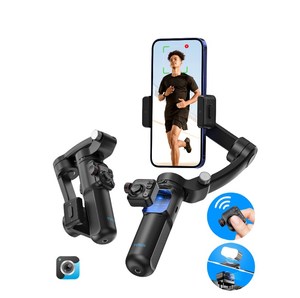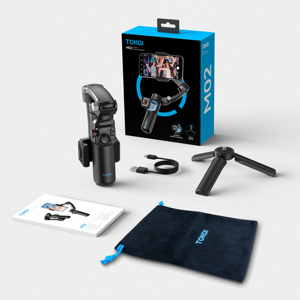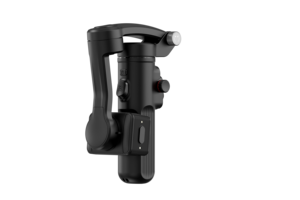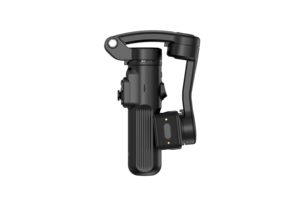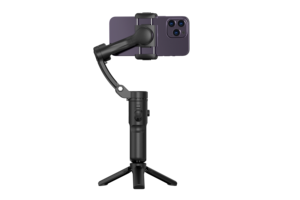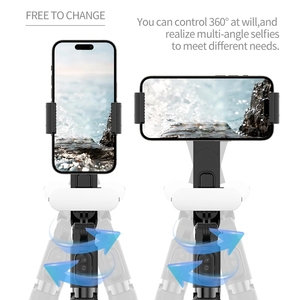Types of Phone Stabilizers
A Phone stabilizer is a tool used to keep a phone steady while recording videos or taking pictures. It works by electronically or mechanically balancing the phone to avoid shaky hands or uneven movements. This results in smooth and steady footage or images. Stabilizers have become popular bringing a professional touch to videos taken with a smartphone. They also come in different types to suit various needs and preferences:
- Mechanical handheld stabilizers: these stabilizers are usually built with weighted arms and a pivoted head. The user balances the phone on the stabilizer's gimbal by moving the arms manually. This helps to achieve steady shots. However, it may require some practice and skill from the user to master the panning and tilting movements properly. That is why mechanical handheld stabilizers are suitable for users looking for a manually operated tool at a more affordable price point.
- Two-axis (tilt/roll) stabilizers: these stabilizers correct two-axis adjustments usually tilt (up and down) and roll (side to side). They are best for shots taken on a level plane, such as panning across a landscape or keeping the horizon steady. Two-axis stabilizers are more affordable than three-axis ones, making them an ideal choice for users on a limited budget or those whose shooting needs don't require the additional functionality of a three-axis model.
- Four-axis stabilizers: just like the two-axis stabilizers, the four-axis ones correct four-axis adjustments usually tilt, roll, and joystick movements. The latter includes any movement on the x, y, and z-axes, which is basically a drift movement. This type of stabilizer is common among those seeking to achieve dynamic and immersive shots, such as fast-paced movements or dji drift correction. It provides an extra level of stabilization, ensuring that footage maintains its composure, even during complex movements.
- Smartphone gimbals: smartphone gimbals are stabilizers that use motors and sensors to electronically stabilize the phone. Gimbals offer more precise control over stabilization than mechanical stabilizers. They feature motorized heads that can be programmed to follow specific motions, such as tracking a subject or sweeping over a scene. Gimbals are ideal for users who need consistent and repeatable stabilization for their shots.
Function and Features
A phone stabilizer has many features that make it easy to use, and they are important for cinematic filming.
- Battery: Most phone stabilizers have rechargeable batteries. They can stabilize a smartphone for several hours. People can finish their entire shoot without running out of power or getting worried about recharging the battery.
- Adjustable Modes : Lots of gimbals come with adjustable modes. These modes allow people to adjust the gimbal to suit their specific filming needs. The modes typically include Follow Mode, Lock Mode, and Drift Mode.
- Clip Mount: Some phone stabilizers have a clip mount feature. This feature allows users to attach the phone stabilizer to other objects. For example, users can attach it to bike handles, tripods, or even some types of chairs. They can expand the possibilities for creative angles and stabilization.
- Three-Axis Stabilization: Modern gimbals offer 3-axis stabilization. This feature helps to minimize three types of movement – tilt, roll, and yaw – along the x, y, and z axes. This three-axis stabilization keeps footage smooth and provides professional-quality video.
- Built-in Filters: Some gimbals come with built-in filters. These filters help to reduce the amount of light that enters the camera lens. They improve the quality of the pictures taken in very bright lighting conditions.
- Trigger: The trigger feature on a gimbal offers instant access to the gimbal's full locking mode. When the trigger is pressed, the three axes will be locked in their current position. This allows the gimbal to create a perfectly aligned shot. The trigger also enables the user to quickly recenter the smartphone on the gimbal.
- Zoom Control: Zoom Control is an important feature of a phone stabilizer. When it is installed on a smartphone with a compatible camera, users can adjust the zoom with ease.
- Weather Resistance: Some phone stabilizers have weather resistance. This means that they are resistant to some conditions like dust, light rain, or splashes.b
N/A
Usage scenarios of a phone stabilizer
Phone stabilizers, commonly referred to as fun stabilizers, have become popular in media production. They help achieve smooth and steady footage. Swinging a light object like a phone can create significant angular momentum, so it's important to keep the apparatus as light as possible. When using a gimbal, it is usually better to hand it over before switching it on; this way, the motors can correct the existing positioning error.
Phone stabilizers serves various purposes, such as:
- Reducing operator-induced disturbances: When the operating hand moves, it usually transfers the movement to the stabilizer. This causes unwanted rotations, translations, and tilting, which can be hard to control. For small-axis movements, the stabilizer can be taken in the opposite direction; for larger strokes, it is better to let it go and switch it on later. In some cases, the operator may need to move the whole stabilizer.
- Guiding and supporting the swinging load: Phone stabilizers are intended to guide a swinging/stabilizing load. This achieves relatively smooth movement so that axes do not suddenly change direction.
- Extending the control time of the phone: The stabilizer enables longer and more controlled shots, which increases the quality of the photos taken and improves fluidity. This stabilizer is particularly helpful for rapid-burst shots.
Phone stabilizers are used in various applications, such as:
- Filmmaking: As mentioned earlier, stabilizers can be used to achieve steady footage. This can be done in walking or running situations or on uneven ground.
- Touring: Phone stabilizers can be used to achieve smooth and steady footage while traveling. It can be used to record walking, biking, or driving scenes.
- Sports: Stabilizers can be used to record action-packed sports scenes with minimal shake.
- Documentary shoot: Stabilizers can be used to record documentary footage with smooth and steady shots, even in challenging situations like crowds or moving vehicles.
How to Choose Phone Stabilizers
When selecting a phone stabilizer, there are several important factors to consider in order to meet specific needs:
- Max Weight Capacity: It is crucial to ensure that the stabilizer's capacity exceeds the weight of the smartphone fully equipped with accessories like a case and lens. This guarantees stability and optimal performance.
- Dimensions: Taking the dimensions of the stabilizer into account is important as it may affect portability and compatibility with different camera rigs or mounting systems.
- Battery Life: Battery life is a crucial factor to consider as it determines how long the stabilizer can be used for extended shooting sessions without needing to recharge. Additionally, battery life affects the stabilizer's overall weight and size.
- Charging time: The charging time of a stabilizer is important as it affects its battery life and overall weight and size. Considering charging time is crucial for extended shooting sessions without recharging.
- Motor type: When choosing a stabilizer, it is important to consider the motor type (brush vs. brushless) as it affects the stability, longevity, and maintenance requirements of the device.
Important considerations when selecting a phone stabilizer include motor speed and capacity, as these factors affect its responsiveness and ability to handle different loads. Features such as dampening, wireless control, and construction material (aluminum vs. plastic) impact stability, functionality, and durability. Accessory mounts and adjustability enhance versatility. Weighing the stabilizer is crucial for identifying its portability and suitability for extended use. Finally, evaluating the cost-effectiveness of a stabilizer requires comparing its features with other similar products to assess its value.
Phone Stabilizer Q & A
Q1: Does a gimbal stabilizer for smartphones make a difference?
A1: Yes, it makes a huge difference. A Gimbal stabilizes the video footage with a motorized system to eliminate any shaky hand movements.
Q2: How do I use a phone stabilizer?
A2: It is usually straightforward. The phone needs to be mounted and balanced first, then powered on. Finally, the controls can be used to capture the desired footage
Q3: what features should be looked for in a phone stabilizer?
A3: Some important features should be taken into consideration, such as weight capacity, battery life, charging system, controls, and build quality.
Q4: Why are phone stabilizers expensive?
A4: The phone stabilizers come with a complex system of motors, sensors, and an electronic software that coordinates the movement.
Q5: How long do phone stabilizers last?
A5: The phone stabilizers are built to last for many years with proper care and use. It can be maintained by keeping it clean and avoiding any harsh impacts.






























































































